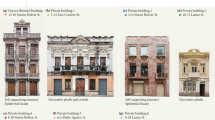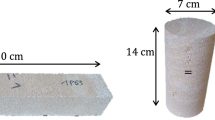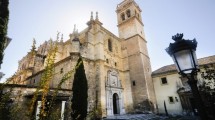Abstract
Ductility is the ability of a material to deform without suffering brittle failure under stresses. Once the load ceases, the acquired deformation maintains over time. On the contrary, a stone is fragile when, subjected to a load, it deforms but, if the load continues, it suddenly breaks. The ductile or fragile facets are homogeneous and isotropic in the stones, but they can mainly vary according to the operating load and temperature. At low temperatures, particularly in polar and subpolar climates, limestone used as a building material and in stone heritage presents an increase in the yield stress. The fragile behavior at lower temperature is higher than at room temperature (20 °C). In this research, the mechanical performance of the Portuguese Blue limestone in dry and saturated conditions and different operating temperatures was accessed in three steps of −20 °C, 0 °C, and + 20 °C. A series of mechanical properties (e.g., uniaxial compressive and flexural strengths, point load strengths index, abrasion resistance, anchorage rupture load, impact resistance, hardness, and abrasion resistance) have been estimated. The results evidence a general progressive increase of the stone’s strengths at low temperature. This is due to a stone decrease in thermal energy and associated reduction in atomic or molecular motion. The reduced motion results in a decrease in internal friction, and it allows the solid to become more rigid, leading to increased mechanical strength. Studying the mechanical properties at various steps of temperatures supports the correct selection of stone materials proper for specific environmental conditions and intended application.



Similar content being viewed by others
References
Alves C, Figueiredo CAM, Sanjurjo-Sánchez J, Hernández AC (2021) Effects of water on natural stone in the built environment—a review. Geosciences 11:459. https://doi.org/10.3390/geosciences11110459
Amaral PM, Fernandes JC, Rosa LG (2008) Weibull statistical analysis of granite bending strength. Rock Mech Rock Eng. https://doi.org/10.1007/s00603-007-0154-7
Bayram F (2012) Predicting mechanical strength loss of natural stones after freeze–thaw in cold regions. Cold Reg Sci Technol 83:98–102. https://doi.org/10.1016/j.coldregions.2012.07.003
Bieniawski ZT (1967) Mechanism of brittle fracture of rock. Part I-theory of the fracture process. Int J Rock Mech Min Sci. https://doi.org/10.1016/0148-9062(67)90030-7
Bonazza A, Messina P, Sabbioni C et al (2009) Mapping the impact of climate change on surface recession of carbonate buildings in Europe. Sci Total Environ. https://doi.org/10.1016/j.scitotenv.2008.10.067
Columbu S, Palomba M, Sitzia F et al (2020) Pyroclastic Stones as Building Materials in Medieval Romanesque Architecture of Sardinia (Italy): Chemical-Physical Features of Rocks and Associated Alterations. Int J Archit Herit 1–18. https://doi.org/10.1080/15583058.2020.1749729
Condie KC (2015) Earth as an evolving planetary system: Third Edition. Academic press. https://doi.org/10.1016/C2015-0-00179-4
Coussy O (2005) Poromechanics of freezing materials. J Mech Phys Solids. https://doi.org/10.1016/j.jmps.2005.04.001
Davarpanah SM, Török Á, Vásárhelyi B (2022) Review on the mechanical properties of frozen rocks. Rud Geol Naft Zb. https://doi.org/10.17794/rgn.2022.3.7
Dias L (2021) STONECOLOR: Color of comercial marbles and limestone – causes and changes. University of Evora
Folk RL (1959) Practical petrographic classification of limestones. Am Assoc Pet Geol Bulletin 43(1):1–38. https://doi.org/10.1306/0BDA5C36-16BD-11D7-8645000102C1865D
Frost E, Dolan J, Ratschbacher L et al (2011) Direct observation of fault zone structure at the brittle-ductile transition along the Salzach-Ennstal-Mariazell-Puchberg fault system, Austrian Alps. J Geophys Res Solid Earth. https://doi.org/10.1029/2010JB007719
He R, He L, Guan B et al (2021) Mechanical properties of a typical Jurassic Shaximiao sandstone under subzero and deep in situ temperature conditions. Front Earth Sci. https://doi.org/10.3389/feart.2021.770272
Heins RW, Friz TO (1967) The effect of low temperature on some physical properties of rock. In: Society of Petroleum Engineers - Drilling and Rock Mechanics Conference, Austin, Texas, January 1967. https://doi.org/10.2118/1714-MS
Kodama J, Goto T, Fujii Y, Hagan P (2013) The effects of water content, temperature and loading rate on strength and failure process of frozen rocks. Int J Rock Mech Min Sci 62:1–13. https://doi.org/10.1016/j.ijrmms.2013.03.006
Kodama J, Goto T, Fujii Y, Hagan P (2013) The Effects of Water Content, Temperature and Loading Rate on Strength and Failure Process of Frozen Rocks. Int. J. Rock Mech. Min. Sci. 62:1–13. https://doi.org/10.1016/j.ijrmms.2013.03.006
Lisci C, Sitzia F, Pires V, Mirão J (2022) Building stones durability by UVA radiation, moisture and spray accelerated weathering. J Build Pathol Rehabil. https://doi.org/10.1007/s41024-022-00196-9
Lisci C, Sitzia F, Pires V, Aniceto M, Mirão J (2023) Stone Endurance: A Comparative Analysis of Natural and Artificial Weathering on Stone Longevity. Heritage 6:4593–4617. https://doi.org/10.3390/heritage6060244
Liu B, Sun Y, Wang J, Zhang G (2020) Characteristic analysis of crack initiation and crack damage stress of sandstone and mudstone under low-temperature condition. J Cold Reg Eng 34. https://doi.org/10.1061/(ASCE)CR.1943-5495.0000225
Matsuoka N (1990) Mechanisms of rock breakdown by frost action: an experimental approach. Cold Reg Sci Technol 17:253–270. https://doi.org/10.1016/S0165-232X(05)80005-9
Mellor M (1973) Mechanical properties of rocks at low temperatures. Permafrost: The North American Contribution to the 2nd International Conference on Permafrost, Yakutsk 13 - 28 July. Natural Academy of Sciences, Washington, DC, pp 13–28
Nicholson DT, Nicholson FH (2000) Physical deterioration of sedimentary rocks subjected to experimental freeze-thaw weathering. Earth Surf Process Landf 25:1295–1307. https://doi.org/10.1002/1096-9837(200011)25:12<1295::AID-ESP138>3.0.CO;2-E
Pires V, Amaral PM, Simão JAR, Galhano C (2022a) Experimental procedure for studying the degradation and alteration of limestone slabs applied on exterior cladding. Environ Earth Sci 81:1–9. https://doi.org/10.1007/s12665-022-10204-3
Pires V, Mirão J, Sitzia F, Lisci C, Duarte J, Dias L, Alves T, Lopes L, Martins R (2022b) Advanced technologies for natural stone|inovstone 4.0-important results from a research project on natural stone construction materials selection and performance analysis. In: Blanco H, Boffill Y, Lombillo I (eds) In Proceedings of the REHABEND 2022. 9th Euro-American Congress on Construction Pathology, Rehabilitation Technology and Heritage Management. University of Cantabria - Building Technology R&D Group, Granada, pp 1337–1350
Ruedrich J, Kirchner D, Siegesmund S (2011) Physical weathering of building stones induced by freeze–thaw action: a laboratory long-term study. Environ Earth Sci 63:1573–1586. https://doi.org/10.1007/s12665-010-0826-6
Shaw MC (1985) Manufacturing processes for engineering materials. Int J Mach Tool Des Res. https://doi.org/10.1016/0020-7357(85)90061-7
Shu S, Yao Z, Xu Y et al (2023) Mechanical properties and constitutive relationship of Cretaceous frozen sandstone under low temperature. Appl Sci 13:4504. https://doi.org/10.3390/app13074504
Simão JAR, Galhano C, Pires V, Amaral PM (2010) Valverde slabs applied on exterior cladding – degradation and alteration study. In: Global Stone Congress, Alicante, Spain
Sitzia F, Lisci C, Mirão J (2022) The interaction between rainwater and polished building stones for flooring and cladding - implications in architecture. J Build Eng. https://doi.org/10.1016/j.jobe.2022.104495
Sitzia F, Lisci C, Pires V, Alves T (2023) Laboratorial simulation for assessing the performance of slates as construction materials in cold climates. Appl Sci 13:2761. https://doi.org/10.3390/app13052761
Stawikowski W (2017) In: 2nd (ed) Structural geology. Geologos. https://doi.org/10.1515/logos-2017-0016
Török Á, Ficsor A, Davarpanah M, Vásárhelyi B (2019) Comparison of mechanical properties of dry, saturated and frozen porous rocks. In: IAEG/AEG Annual Meeting Proceedings, San Francisco, California, 2018—Volume 6
Yang Y, Wang J (2022) Study on deterioration effect of dynamic mechanical properties of granite at subzero temperatures. Geofluids 2022:1–11. https://doi.org/10.1155/2022/3899268
Yang Y, Zhang N, Wang J (2021) A study on the dynamic strength deterioration mechanism of frozen red sandstone at low temperatures. Minerals 11:1300. https://doi.org/10.3390/min11121300
Zhamaletdinov AA (2019) On the nature of the brittle-ductile transition zone in the earth’s crust (review). In: Zhamaletdinov A, Rebetsky Y (eds) The Study of Continental Lithosphere Electrical Conductivity, Temperature and Rheology. Springer Proceedings in Earth and Environmental Sciences. Springer, Cham. https://doi.org/10.1007/978-3-030-35906-5_3
Zhang D, Lu G, Wu J et al (2023) Effects of ultralow temperature and water saturation on the mechanical properties of sandstone. Rock Mech Rock Eng. https://doi.org/10.1007/s00603-023-03229-y
Funding
Carla Lisci gratefully acknowledges the FCT for the grant SFRH/BD/149699/2019 co-funded by the European Social Fund (ESF) and MEC national funds. Fabio Sitzia gratefully acknowledge the Recursos Humanos Altamente Qualificados for the contract with Ref. ALT2059-2019-24. Vera Pires gratefully acknowledge the Contrato Programa entre FCT e a Universidade de Évora no âmbito do concurso estímulo ao emprego científico institucional 2018. The authors gratefully acknowledge the following funding sources: INOVSTONE4.0 (POCI-01-0247-FEDER-024535), co-financed by the European Union through the European Regional Development Fund (FEDER) and Fundação para a Ciência e Tecnologia (FCT) under the project UID/Multi/04449/2013 (POCI-01-0145-FEDER-007649), and Fundacao para a Ciencia e Tecnologia (FCT) under the project UIDB/04449/2020 and UIDP/04449/2020. The authors gratefully acknowledge the European Communion—Portugal, Grant Contract number: Sustainable Stone by Portugal, Call: 2021-C05i0101-02—agendas/alianças mobilizadoras para a reindustrialização—PRR, Proposal: C632482988-00467016.
Author information
Authors and Affiliations
Corresponding author
Ethics declarations
Competing Interests
The authors declare no competing interests
Rights and permissions
Springer Nature or its licensor (e.g. a society or other partner) holds exclusive rights to this article under a publishing agreement with the author(s) or other rightsholder(s); author self-archiving of the accepted manuscript version of this article is solely governed by the terms of such publishing agreement and applicable law.
About this article
Cite this article
Sitzia, F., Pires, V. & Lisci, C. Exploring the Mechanical Properties of Stone Heritage: Investigating the Effects of Low Temperatures on Ductile — Brittle Transition. Geoheritage 15, 123 (2023). https://doi.org/10.1007/s12371-023-00892-z
Received:
Accepted:
Published:
DOI: https://doi.org/10.1007/s12371-023-00892-z




